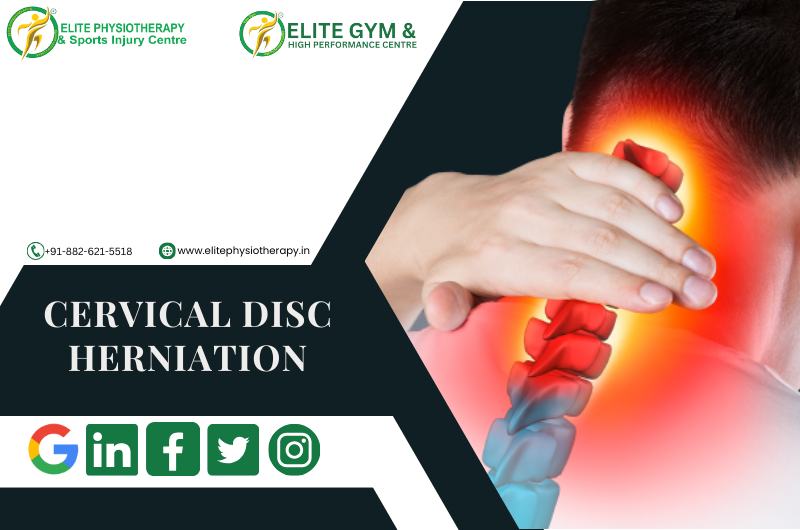Introduction
Cervical disc herniation is a prevalent condition that can significantly impact daily life. Our specialty at Elite Physiotherapy and Sports Injury Centre is offering thorough, non-invasive pain relief and function restoration therapies. Focusing on the cutting-edge modalities offered at our facility, this study explores the causes, mechanisms, clinical characteristics, diagnostic techniques, and physiotherapy management of cervical disc herniation.
Understanding Cervical Disc Herniation
Intervertebral discs, which serve as cushions and promote mobility, divide the seven vertebrae that make up the cervical spine. When the nucleus pulposus, the gel-like center, pushes through a rupture in the annulus fibrosus, the tough outer layer, it might cause a cervical disc herniation, which could compress the spinal cord or neighboring nerve roots.
Causes
Common causes of cervical disc herniation include:
- Disc Degeneration: Dehydration and a lack of disc elasticity brought on by age-related wear and tear might make discs more prone to tearing.
- Trauma: Abrupt injuries, such as whiplash from falls or auto accidents, can result in disc herniation right away.
- Repetitive Stress: Over time, repetitive neck motions or bad posture can cause constant tension that can lead to disc injury.
Mechanism of Injury
An excessive amount of pressure or tension on the cervical spine usually results in tears in the annulus fibrosus, which is the mechanism of damage. This makes it possible for the nucleus pulposus to herniate, which could compress the spinal cord or nerve roots and cause neurological symptoms.
Clinical Features
Individuals with cervical disc herniation may experience:
- Neck Pain: A localized ache that could get worse when you move.
- Radicular Pain: Severe, shooting pain that travels down the arm, hand, or shoulder from the neck.
- Numbness and Tingling: Pins-and-needles sensations in the afflicted arm or fingers.
- Muscle Weakness: Inability to hold or lift objects because of weak hand or arm muscles.
- Reduced Range of Motion: Neck stiffness and restricted motion.
Diagnostic Methods at Elite Physiotherapy and Sports Injury Centre
To properly diagnose cervical disc herniation, a comprehensive physical and functional evaluation is carried out at our clinic, including specialized physiotherapy tests. These evaluations could consist of:
- Spurling’s Test: Reproducing symptoms of nerve root compression by gently pressing on the head.
- The cervical distraction test: Involves gently raising the head to check for symptoms that could indicate nerve root involvement.
- Upper Limb Tension Tests: Evaluating the sensitivity and mobility of the upper limbs’ nerves.
- Manual Muscle Testing: Assessing muscle strength manually to pinpoint particular deficiencies linked to nerve compression.
These tests help in formulating a personalized treatment plan tailored to the patient’s specific condition.
Physiotherapy Management at Elite Physiotherapy and Sports Injury Centre
Our approach focuses on alleviating pain, improving mobility, and preventing recurrence through a combination of advanced physiotherapy techniques and modalities.
Pain Management
- Manual therapy: Techniques for gently mobilizing the spine to improve mobility and lessen pain.
- Electrotherapy: Pain relief through the use of techniques such as transcutaneous electrical nerve stimulation (TENS).
Advanced Modalities
We offer state-of-the-art treatments to enhance recovery:
- Shock Wave Therapy: Non-invasive pulses help injured areas heal and feel less pain.
- Super Inductive System: High-intensity electromagnetic fields are used in the Super Inductive System to reduce pain and encourage tissue regeneration.
- High-Intensity Class 4 Laser: Laser therapy is delivered by a high-intensity class 4 laser, which speeds up healing and reduces inflammation.
- Hydrotherapy: Exercises using water to gradually increase strength and flexibility without putting undue strain on the cervical spine.
- Cryotherapy: Using cold therapy to reduce inflammation and numb painful tissues.
Therapeutic Exercises
- A customized exercise program is designed to strengthen neck and shoulder muscles, improve posture, and enhance flexibility. These exercises aim to support the cervical spine and reduce the risk of future injuries.
Ergonomic and Postural Training
Education on maintaining proper posture during daily activities and ergonomic adjustments to workstations to minimize strain on the neck.
conclusion
At Elite Physiotherapy and Sports Injury Centre, our multidisciplinary team is dedicated to delivering personalized care using the latest advancements in physiotherapy. Our goal is to help patients achieve optimal recovery and prevent future occurrences of cervical disc herniation.

